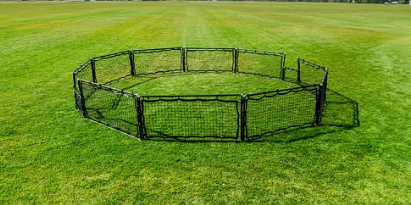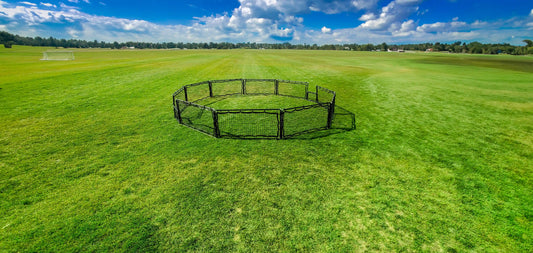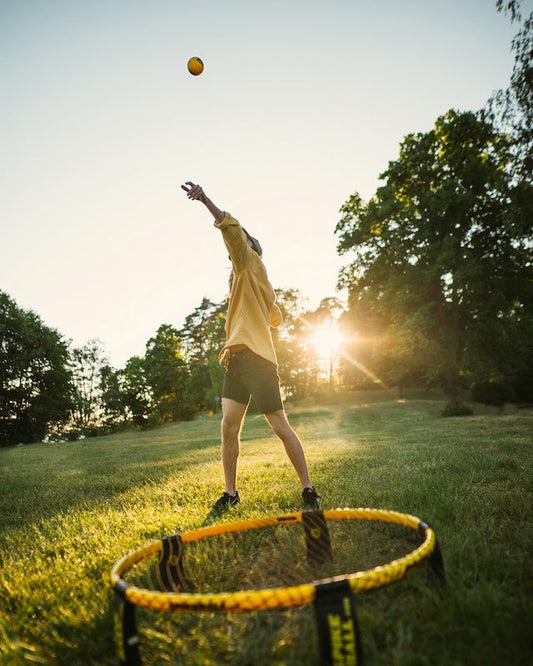Keeping high school students entertained during gym class can seem difficult at times. Because they are in such social stage in their life it is important to implement a lot of team building and team bonding activities. Many of them are in sports groups and can benefit from games that improve their leadership skills, team dynamics and problem solving skills. Trying to motivate these students to want to participate it is important to know your students personally and get to know their strengths and weaknesses so that you van challenge each student depending on their level. You can evaluate this through big or small group games. Students tend to be more interested in game when they can see their growth and can begin to enjoy sports and know how to work with a team.
1. Disk Golf

Disk Golf follows the same premise of traditional golf but uses frisbees instead of clubs and golf balls. The goal is to get the disk into the hole in the lowest number of throws. These goals which is referred to as “holes” in dic golf can be set up using Infinet set. By taking a couple panels from your set you can create 3 holes at at a time. To play disk golf at your school, you will need to set up a disk golf course in a big open space. Feel free to set up obstacles along the way to make the throws more interesting. Additionally, remind the kids not to throw a disk if another student is walking in front of them.
Before starting, give each kid a pen and paper to keep track of their score. If practicing and not keeping score, don’t give out the paper.
Show the students how to step up to the tee to throw the disk towards the hole. After a student throws, they continue their next throw from where the first disk fell. They continue this until their disk lands in the hole. The participant can keep track of the number of throws and improve each time they complete the course.
Of course, there’s more technique to the game. Players can choose disks of different weights, sizes, and shapes to change how the disk will fly through the air. However, for your PE class, pick multi-purpose disks to show the students the disk golf basics.
Once the students understand the sport, you can explain the differences between a putter and a driver. There are also different ways to throw the disk and different ways to stand as you throw. That being said, don’t expect the students to become professional disk golfers when they leave the classroom. If the students enjoy disk golf, make the course accessible to them after class and during each field day. You can make this a competition between players or a competition for a single player against themselves as they strive to get better scores thought the game. This can allow players to uncover a hidden talent, work toward a common goal, and heighten team spirit.
2. Ultimate Frisbee
Ultimate Frisbee is a cross between soccer, football, and frisbee. Each team has seven players, with fourteen on the field at the same time between both teams. Divide participants into groups of seven and then rotate the entire team in and out of the field, so each team gets a chance to play each of the other teams.
The field is separated into two end zones. The goal is to get a team’s frisbee into the other team’s end zone, this end zone can be created with cones, lines or Infinets set up as a goal. Each time a team successfully catches their frisbee in the other team’s end zone, they earn one point. The first team to 15 points wins the game.
However, players can’t simply run with the frisbee from one end of the field to the other. Instead, Ultimate Frisbee requires coordinated teamwork, which helps each kid learn the importance of team building and trusting your peers.
The game starts with both teams lined up at their end zone. The team starting as defense throws the disk to the offense, allowing the offense to pick up wherever the disk lands or is caught. Once a player catches the frisbee, they can only take three steps and must throw the frisbee within ten seconds. Because of the counted steps and quick action time the players learn to think fast and develop team dynamics as they plan their formations so they can score.
If a throw is unsuccessful, the defense takes the frisbee and becomes the offense. The game continues until one team wins. The game doesn’t allow for any physical contact at all, making it a safe game for high school gym class
3. 9 Square

9 square is an indoor or outdoor team building activity that combines volleyball and four square. This game is designed to encourage team morale, teamwork and team bonding. Players stand inside one of the nine squares and hit the ball to keep it in motion, the goal of each participant is to avoid elimination while challenging their opponents. The middle square is the King or Queen square. The rest of the positions spiral out until the bottom corner is square nine, the starter square. If a player misses the ball, they have to move down to the last square, and all other players move up.
The game's goal is to get to the King or Queen square and then stay in that position. All players have the same chance to move up, meaning that everyone is on an even playing field. If someone hits the ball out, they're out. If they drop the ball, they're out.
9 Square is the perfect game for a tournament, as those who maintain their place as King or Queen move up and others move down. Because 9 Square is always changing, it will keep kids (even high schoolers) entertained for a full PE class. It's one of the best rainy day games. This game accommodates up to 9 players at a time, making it ideal for schools, youth ministry groups, and community centers. Due to the customizable height, kids and adults can play, this way everyone can get involved in this fast-paced, competitive, and inclusive game.
3. Touch Football
A great PE game for high school students is Touch Football. Touch Football encourages physical activity and can be played outdoors or in a gymnasium. Touch Football’s goal is to score points by running the ball into the other team’s end zone. The promise of the game is very similar to regular football but without the risk of severe injury. Touch football can be players in both big and small groups from a team of 6 to a team of 14 players.
Traditional football is risky to play in a physical education class because players are likely to be injured due to tackling, dog piles, and shoving. There all result in thousands of football-related injuries every month. To avoid the risk of injury, play touch football instead of traditional football.
In Touch Football, a touch counts when one player touches another player on a part of the body, including legs, shoulders, arms, or feet, similar to playing tag. If someone tackles another player, they receive a penalty or be kicked from the game, depending on how purposeful the tackle was. Touch football allows each team to develop team dynamics and create a game plan together to promote teamwork. It involves high energy and healthy competition.
4. Dodgeball
One of the best games for a high school gym class is dodgeball. Dodgeball is easy to set up and encourages all students to participate. It’s also competitive without being overly competitive.
Dodgeball’s goal is to eliminate all players on the opposite team. Most games play within a ten-minute time limit--if the game lasts longer than ten minutes, the team with the most players left wins. To play, you will need at least four people on either team, but more are always welcome.
Start by lining up rubber balls along a center line. On a count of three, the two teams will sprint towards the balls and begin throwing them at the other team. If someone gets hit with a ball, they’re eliminated. To win the game (before ten minutes are up), players must eliminate all players from the opposite team.
In some versions of the game, players can come back into the game when a team member catches a ball thrown by the opposite team. If this happens, the player in line can come back in while the opposite player is eliminated. Players aren’t eliminated from the game if they are hit above the shoulders or if they are hit by a ball that bounced off a wall or ceiling.
Dodgeball is perfect for high school students because there are nearly endless variations to the game. One variation is called Reverse Dodgeball. In Reverse Dodgeball, both teams start with one player on the court. If one player hits the other with the rubber ball, they get to have a second player join them on the court. In this version, no one is eliminated; instead, players only join the game. The first team to have all of their players join the court wins.
5. Capture the Flag
Capture the Flag is a classic game for all ages. Students can choose to be on offense or defense and play a role where they feel comfortable. This lets students both step out of their comfort zones without feeling stressed or incapable. Capture the Flag is a fast-paced and fun game that allows friendly competition and teaches leadership skills in a fun way
To play, you will need two teams. There’s no limit to how many players can be on either team. To make it fair, randomly create two teams using every student in the classroom. You will also need a playing space that is large enough for the students to run from one side to another. This is an ideal game for playing outside in a grassy field with bushes and trees, you can also play Capture the Flag inside the gym if needed.
Give each team one flag to hide somewhere on their side of the play area. This flag will be their team’s flag that they will need to protect. If the opposite team steals their flag and brings it over the middle line separating the two team’s sides, the opposite team wins. If you're playing inside you can be creative setting up obstacle courses by using Infinets as bases for your flag, or cones that players are required to jump over, or lines they have to circle this makes it more challenging for the game to be played and points to be scored. It can help the entire team think strategically and help protect the player with the flag to not get tagged.
Each player will also need one flag tied around their waist. Velcro flags are usually best because they fall off with a simple tug. When a player is on the opposing side (running as an offense), the opposite team can grab their flag. If the player loses their flag, they have to go to the opposite team’s “jail.” They can be released from jail if the referee calls a jailbreak or if one of their players sneaks across the field and tags the player in jail. Having to rely on a team member to get you out of jail implements team building and bonding activities as it reflects the need for every single player. The game is simple and exciting because the players strategize together in a fast-paced, team building game. It’s a fun game for every high school PE class.
6. Hunger Games Competition

Incorporating popular culture into your PE class is a great way to engage every student in the gymnasium. Although kids of all ages will love this game, it’s a great physical activity specifically for high schoolers. It requires students to work together as a team while defending a fort from three different angles. Additionally, it requires few materials, making it an easy game to set up.
To start, create the court. For the court, separate the gym into four equal parts. One team will occupy each rectangle and will be confined to their space. On the outer corner of each rectangle, section off a smaller square. This square will house the group’s base (their hula hut).
Next, you will need safe-to-throw balls and 25 hula hoops. Place all of the balls in a hula hoop overlapping all four sections in the center of the play area. Then, give six hula hoops to each team. The teams will bring their hula hoops to their base square and create a hula hoop hut. You can watch this video to see how to build a hula hoop hut. The team to build the hula hoop hut first earns an additional two-second head start.
After the huts are finished, have the teams race towards the center hula hoop (the cornucopia). As the players reach the cornucopia, they grab balls and throw them at the other team’s huts. If the hut falls, the team sits down and is out of the game.
The last team standing wins the Hunger Games.
This is a exciting, entertaining and fun game that allows the teams to use their team architect skills to build a strong hula hoop fort. Teams will have fun building their hula hoop hut and look forward to knocking down their opponents’ huts. It’s the perfect game for all occasions as it shows team spirit and determination in your students.
7. Hoop Scrabble
Hula Scrabble is an easy, fun game perfect for getting students to think and strategize their next move. The game feels like a competition that you might see on the survival show “Survivor”. It requires teams to work together to solve a puzzle, racing the clock and their classmates.
To play, you will need a hula hoop for every team. Divide participants into teams of four and assign each team to a hula hoop. Once the teams have been assigned to their hula hoops, lay out lettered items at the front of the room. These items can be ping pong balls, index cards, scrabble tiles, or tennis balls (the PE teacher should letter each of the items). You will need enough tiles to have at least four tiles per team.
Start the game by randomly assigning an order to the groups. One by one, each group member will come up to the front and take a random tile until there are no more tiles. Once each team has their tiles, they will begin spelling.
The teacher picks a category for the word. For example, the teacher could say:
Spell a four-letter word
Spell a dog’s name
Spell a sound you make when upset
Spell a four-letter word
Spell a type of animal
The kids will frantically start thinking of a word to fit in the category. Most of the groups won’t have the tiles they need to spell the word, this is where the competition comes into play. One player can leave the team to be a “runner.” The runner can go to other groups and steal one letter. After stealing a letter, they must return it directly to their group. They have a three-second cool-down before they can leave the group again to steal another letter. This game is played best when one player is designated as runner, one as leader, one as word assembler and all the rest as thinkers or watchers to tell the runner what to get. Without each member playing their role the team can lose. The runners ensure that tiles are constantly changing hands, especially if more than one group is trying to spell the same word. In this game, it pays to think outside the box. As soon as a group spells a word, they yell out their word as loud as possible, stopping the game. At this point, everyone freezes. The teacher approaches the groups and checks that the word fits the category and is spelled correctly. If it doesn’t fit the category, the game unpauses, and the other groups have a chance. The failed team can also reevaluate and keep trying to spell a correct word. This is a team building activity that drives an entire team to work together toward a common goal. It can be used in youth ministry or school classes to learn new words or topics in a fun way.
This game is fun because you can play with endless categories and even allow students choose the next category. Students will have fun because it’s an a typical activity and will be a new addition to the games they know.
8. Yoga

High school students deal with a lot of stress. They have endless homework from teachers and often navigate difficult situations at home or with friends. Because of this, many high school students arrive at school feeling frustrated and overwhelmed. Gym teachers can make gym class a safe haven by incorporating team-building activities such as yoga once a week. Yoga is an excellent team-building exercise that not only promotes individual well-being but also strengthens team dynamics and team spirit among students.
Yoga has endless health benefits for the body. It encourages flexibility, circulation, and decreases stress. Introducing yoga as a youth group game or a fun team-building activity can help students bond while improving their mental and physical health.
Team Building Through Yoga
Introduce yoga by hosting a yoga class once a week. Lead the students through a basic yoga flow and teach them different types of yoga. Yoga can serve as a fun way to develop teamwork, team morale, and leadership skills. Some of the best yoga types for youth group team building include:
Vinyasa Yoga
Vinyasa involves active movement, helping students learn how to flow from one position to another. This is a great way to develop team dynamics as students practice synchronized movements, fostering a sense of teamwork and fun competition. You can have each student teach the class a different move to develop teaching skills.
Yin Yoga
If your students look especially stressed, introduce Yin yoga. This practice focuses on deep stretching, helping students release tension and develop problem-solving skills through mindfulness. It also helps in team bonding as participants experience relaxation together.
Ashtanga Yoga
Once students have practiced yoga for a while, they may be ready for Ashtanga yoga. This structured practice involves memorizing sequences, promoting discipline, teamwork, and skill-building. As students master sequences, they develop a common goal and a strong sense of accomplishment.
Yoga as a Fun Team-Building Game
To make yoga an engaging team-building game, divide participants into small teams and have them work on mastering different yoga poses together. This can be a fun game and a friendly competition where the winning team successfully completes a sequence of poses without breaking form. It is an excellent team-building exercise for both large groups and smaller teams.
Another fun activity involves a relay race where team members pass a hula hoop through a yoga pose. This encourages teamwork, enhances team spirit, and provides a fun way to build problem-solving skills.
Using yoga in your class can help students learn how to release stress while also engage in bonding activities that strengthen their relationships. Whether working in smaller groups or large group settings, yoga is an effective team building activity that promotes teamwork, healthy competition, and skill development. It also teaches students a new hobby and possibly a hidden talent that can benefit them throughout their lives.
9. Gym Skate

Gym skate lets high school students relax and have fun. Students can skate and move around the gym freely during this activity, learning new skills or simply pretending they’re kids again.
Depending on the resources that you have available, there are several options for this activity. The first and most accessible option is by using slippery socks on the gym floor. Either give out a pair of socks to each student or instruct them to bring socks to PE class.
Once all the students are wearing socks, show them how to slide around on the gym floor wearing their socks. It’s a child-like activity that encourages the students to stop caring what others think about them. Instead, it lets the students let go of expectations and act like children again.
In this activity, the goal is to encourage the kids to “skate” around the gym while wearing slippery socks. You can create challenges or races for the kids to do while wearing the socks (with the rule that they’re never allowed to take their feet from the floor).
If your school has access to more resources, teach the kids a new skill and a new form of exercise, skating. Bring roller skates for each student and hold a class on how to roller skate. If you have a free unit for the semester, teach an entire class on roller skating. The goal of this activity will be to teach the students a new skill or hobby. By the end of the unit, at least one student will start roller skating in their free time.
Because most schools won’t have access to roller skates, it will be easier to wear socks. The kids will have just as much fun running around the gym and trying to slide across the floor. It’s the perfect activity for a rainy day.
10. Traditional Sports

You can always fall back on playing traditional sports. Most PE classes will have access to basketball courts, volleyball courts, a soccer field, and track equipment. To keep the students engaged in these activities, you will need to structure the gym time rather than turning the gym class into free-play. Free-play can be effective for some classes; however, gym classes with more than one student refusing to participate will benefit more from having structured gym time.
To help structure your traditional sports activities, here are ideas for basketball, volleyball, and soccer:
Basket Activities
One of the easiest basketball activities to introduce to your students is HORSE. To play HORSE, you will need one basketball per group. If there are four basketball hoops in the gym, you can play with four teams simultaneously. Each team needs exclusive access to a basketball hoop.
One person starts the game by taking a unique throw at the basketball. Before throwing, they specify the rules of the throw, saying, “I’m throwing with my eyes closed.” If they miss the shot, the next player gets to choose the throw. However, if they make the shot, the next person must throw the basketball exactly like the first. If they miss the shot, they earn an “H.” This pattern continues until someone earns all the letters in HORSE and is eliminated. The last player left in the game wins.
Volleyball Activities
After your volleyball unit, change the pace by playing life size Battleship on the volleyball court. To play, cover all the nets with large sheets so that both sides of the court are obscured from the other. Teams pick positions on their side of the court by laying down and covering their face with their hands (for protection).
The starting side takes a safe-for-throwing ball and tosses it over the net. If they don’t hit any of the players lying on the floor, a referee calls out, “Missed!” The next team gets to throw over the net. If a player is hit twice, their “ship sinks.” If one team loses all their ships, the opposite team wins.
The game is simple, easy, and a funny deviation from volleyball after you finish the volleyball unit but haven’t taken down the volleyball courts.
Soccer Activities
A fun activity for the middle of your soccer unit is a soccer obstacle course. Be creative when setting up the obstacle course and use equipment such as a balance beam, jump rope, pool noodle or Infinets assembled in a pattern or wall to make the course more interesting.
The goal of the obstacle course is to help the kids improve their coordination and aim. Throughout the course, create challenges where the students have to kick a soccer ball at a cone before they can move on to the next part of the court. In one area, set up a balance beam that the kids have to walk across before juggling the soccer ball to a new area.
No matter the age of your students, it’s important to make exercise fun. PE class sets a foundation for how students view exercise, helping them to see it as a fun, essential part of a daily routine sets the pace for the rest of their lives.







